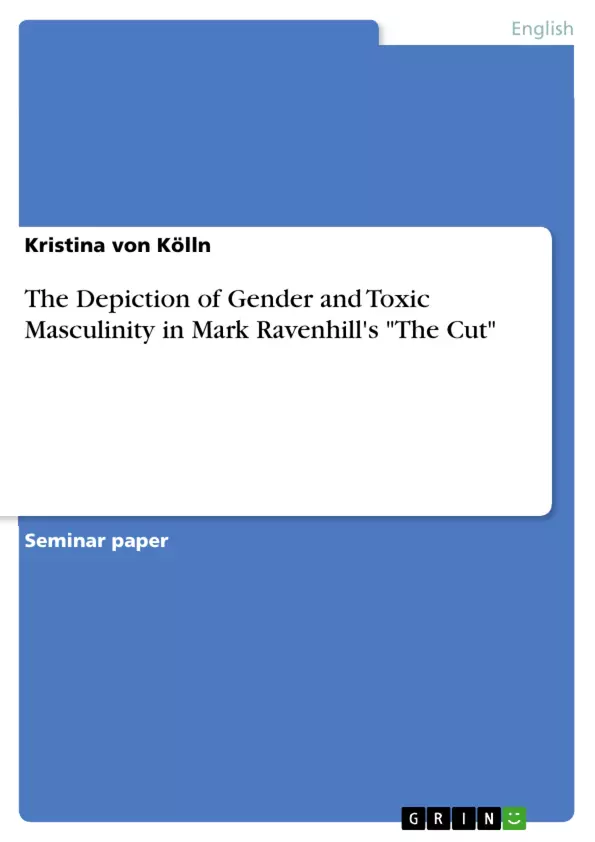This paper examines the depiction of gender in Mark Ravenhill's play The Cut. Special emphasis is hereby placed on the aspect of "toxic masculinity" - a topic which has not lost its relevance since its first definition in the 1980s. Toxic masculinity and patriarchal dystopian systems are closely intertwined and have for some time found their place in feminist dystopian narratives such as The Handsmaid Tale by Margaret Atwood, Octavia Butler's Wild Seed or Vox by Christina Dalcher. At first glance, Marc Ravenhill's The Cut fits into this list only in terms of the dystopian moment. However, upon closer inspection, his play, which focuses almost exclusively on the male characters, also reveals the effects of patriarchal cultures and toxic masculinity on both the female and, in particular, the male members of society. Nevertheless, the aspect of gender and especially toxic masculinity has not yet been dealt with in the context of Ravenhill's work. Merle Tönnies, for example, concentrated primarily on the aspect of the immobility of power in her detailed analysis of The Cut, while Robert Kielawski placed his focus on "the reinvention of utopia revolution and the big Other in decline" (Kielawski) - the aspect of gender inequality, however, did not seem to play a role for either of them. Furthermore, neither the critics, nor Ravenhill himself addressed the topic.
In order to fill this gap, the present work will analyse The Cut based on the thesis that Marc Ravenhill's The Cut represents a patriarchal dystopia whose members suffer from the effects of toxic masculinity. In the course of this paper Marc Ravenhill and The Cut will be briefly introduced, followed by a theoretical background on gender in dystopian fiction in general and toxic masculinity in particular, and finally the depiction of gender and toxic masculinity in The Cut. In order to be able to undertake an analysis that is as detailed as possible, despite the limited scope of this work, Chapter 4 will focus primarily on the main character of the play, Paul, in order to highlight the aspects of toxic masculinity. However, this should not lead to the assumption that not all other characters would also show similar symptoms.
Inhaltsverzeichnis (Table of Contents)
- Introduction
- Mark Ravenhill's The Cut
- Theoretical Background
- Gender in Dystopian Fiction
- Toxic Masculinity
- The Depiction of Gender in The Cut
- Aspects of Toxic Masculinity in The Cut
- Conclusion
Zielsetzung und Themenschwerpunkte (Objectives and Key Themes)
This paper explores the portrayal of gender in Mark Ravenhill's play The Cut, focusing on the theme of "toxic masculinity". The paper aims to analyze how the play depicts the effects of patriarchal cultures and toxic masculinity on both male and female characters within a dystopian setting.
- The intersection of toxic masculinity and patriarchal dystopian systems.
- The depiction of gender roles and power dynamics in the play.
- The impact of toxic masculinity on individual characters, particularly the protagonist Paul.
- The exploration of the psychological and emotional consequences of living in a dystopian society.
- The role of the "cut" as a symbol of societal control and individual subjugation.
Zusammenfassung der Kapitel (Chapter Summaries)
- Introduction: This chapter provides an overview of the paper's objectives and establishes the context for exploring the depiction of gender in Mark Ravenhill's The Cut. It highlights the significance of "toxic masculinity" as a theme and explores how the play contributes to the wider discussion of feminist dystopian narratives.
- Mark Ravenhill's The Cut: This chapter introduces the play's author, Mark Ravenhill, and provides background information about his career and artistic style. It also summarizes the plot of The Cut, focusing on the main character Paul, his professional life as a surgeon carrying out the mysterious "cut," and the impact this has on his personal relationships.
- Theoretical Background: This chapter delves into the theoretical frameworks relevant to the paper's analysis. It examines the concepts of gender in dystopian fiction and toxic masculinity, providing definitions and key insights from relevant scholarship.
- The Depiction of Gender in The Cut: This chapter examines how gender is portrayed in The Cut, focusing on the aspects of toxic masculinity. It analyzes the behaviors and interactions of the main characters, particularly Paul, to illuminate the consequences of toxic masculinity on individual lives and the broader social fabric.
Schlüsselwörter (Keywords)
The key terms and concepts explored in this paper include: toxic masculinity, dystopian fiction, gender roles, patriarchal structures, power dynamics, psychological effects, societal control, individual subjugation, and the "cut" as a symbol.
- Citar trabajo
- Kristina von Kölln (Autor), 2020, The Depiction of Gender and Toxic Masculinity in Mark Ravenhill's "The Cut", Múnich, GRIN Verlag, https://www.grin.com/document/948613



